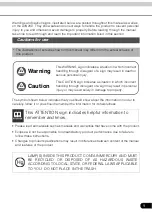
18
Option [32]: Communication Select
If the MLR2-DG Receiver is not to be used with central
station automation software and a computer, program Option
[32] as “00”.
If the MLR2-DG is to be used with central station automation
software, program Option [32] with one of the values listed
below:
Value
Function
00
No communication to computer
01
Alarms communicated to computer. If the
alarm is reported in 3/1, 3/1 extended, 3/2 or
3/8 ACRON formats, a leading space will be
communicated in front of the 3-digit Account
Codes when sent to the computer
Ex:
1011ssssss
s
AAAsXsssY[DC4]
02
Alarms communicated to computer. If the alarm is
reported in 3/1 3/1 extended, 3/2 or 3/8 ACRON
formats, a leading “0” (zero) will be communicated
in front of the 3-digit Account Codes
Ex:
1011ssssss
0
AAAsXsssY[DC4]
03
Alarms communicated to computer. If the alarm
is reported in 3/1, 3/1 extended, 3/2 or 3/8
ACRON formats, a leading “0” (zero) will be
communicated in front of the 3-digit Account
Codes. If the alarm is reported in 3/1 or 4/1
formats, a leading “0” (zero) will be
communicated in front of the 1-digit alarm code
Ex:
1011ssssss
0
AAAsXss
0
Y[DC4]
[DEFAULT 01]
Option [33]: Printer Enable: Communicate Information
to Printer Through CPM2
If a printer is not used with the MLR2-DG, program Option
[33] as “00”.
If a printer is to be used with the MLR2-DG, program Option
[33] with one of the values listed below:
00
Printer not selected
01
Printer selected
[DEFAULT 01]
Option [34]: Receiver Number
The Receiver Number is used for sending signals to the
central station software. This number should be the same
for all DRL2A Line Card modules connected to the same
CPM2.
Refer to the manuals for any central station automation
software being used to determine if there are any special
requirements for this number. Also, check the numbers used
for any other receivers in the station to ensure that numbers
are not duplicated.
[DEFAULT 01]
Option [35]: Line Card Number
The Line Card Number provides a unique identification code
for each Line Card in the DRL2A module. Since the CPM2
can be connected to a total of 14 Line Cards, it is very
important to program a unique code for each of the Line
Cards. Failure to do so will cause “clashes”, where two
Line Cards answer the same CPM2 polling message at the
same time. Hexadecimal numbers “01” to “0E” can be
programmed in Option [35] to identify Line Cards 01 through
14.
Option [36]: Caller Identification (Call Display) Option
Option [36] allows the Line Card to receive Caller Identification
data that is transmitted after the first ring on the telephone
line.
Program “01” to enable this feature, or program “00” to
disable it. The “Call Display” service must be available and
requested from the Telephone Company for this feature to
be operational.
Program Option [36] with one of the following:
00
No reception
01
Normal reception operation with checksum verify
02
Reception without checksum verify
The following library messages are used with
Option [36]:
PrivateCall
:
An anonymous indication is received instead
of the originating telephone number
No call no.:
An out-of-area or unavailable indication is
received instead of the originating telephone number
UnknownCall:
The originating telephone number has not
been received or was not transmitted
[DEFAULT 00]
Option [37]: Send Caller-Identification (Telephone
number) to Computer
The DRL2A can send the Caller-Identification numbers to
the computer. If the telephone number is not received, the
Caller Identification information will not be sent to the
computer.
Program Option [37] with one of the following:
00
Do not send Caller Identification
01
Send Caller Identification for every call
02
Send Caller Identification only when fault call or
fault data is received
03
Send Caller Identification for every call without
the “1” long distance indicator
04
Send Caller Identification only when fault call or
faulty data is received, and send the information
without the “1” long distance indicator
Note that option [36] must be programmed as "01".
[DEFAULT 00]
Option [38]: Send Caller Identification to Printer
To use Option [38], Option [36] must be programmed as
“01”.
Program Option [38] with one of the following:
00
Do not send Caller Identification to printer
01
Send alarm code and Caller Identification to printer
instead of the english alarm message. The printer
library must be removed at option [30]. Note that
10-40 baud and 4/3 formats only will be printed
with Caller Identification. Contact ID and SIA formats
will be printed with two lines. The first line will be
the alarm message and the second line will be
the caller-ID.
02
Send Caller Identification to printer only when fault
call or faulty data is received
[DEFAULT 00]
Option [39]: Line Check
The Line Card will perform a telephone line test every 10
seconds. When Option [39] is enabled, if the line is faulty,
a warning message will be displayed on the Line Card
screen and an alarm will be sent to the computer and the
printer. When option is disabled, no alarm will be transmitted.
















































